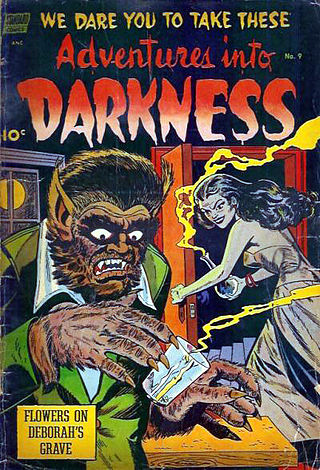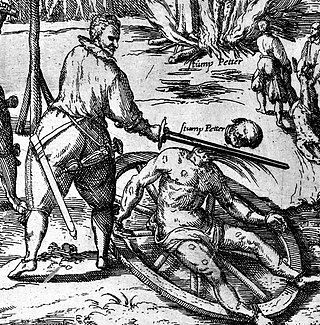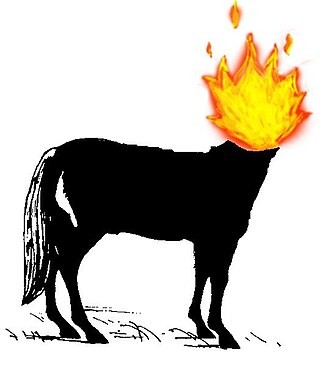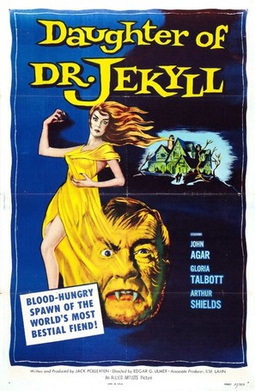
In folklore, a werewolf, or occasionally lycanthrope is an individual who can shape-shift into a wolf, either purposely or after being placed under a curse or affliction, with the transformations occurring on the night of a full moon. Early sources for belief in this ability or affliction, called lycanthropy, are Petronius (27–66) and Gervase of Tilbury (1150–1228).
Shit is an English-language profanity. As a noun, it refers to fecal matter, and as a verb it means to defecate; in the plural, it means diarrhea. Shite is a common variant in British and Irish English. As a slang term, shit has many meanings, including: nonsense, foolishness, something of little value or quality, trivial and usually boastful or inaccurate talk or a contemptible person. It could also be used to refer to any other noun in general or as an expression of annoyance, surprise or anger.

Mafia, also known as Werewolf, is a Russian social deduction game created by Dimitry Davidoff in 1986. The game models a conflict between two groups: an informed minority and an uninformed majority. At the start of the game, each player is secretly assigned a role affiliated with one of these teams. The game has two alternating phases: first, a night-phase, during which those with night-killing-powers may covertly kill other players, and second, a day-phase, in which all surviving players debate and vote to eliminate a suspect. The game continues until a faction achieves its win-condition; for the village, this usually means eliminating the evil minority, while for the minority, this usually means reaching numerical parity with the village and eliminating any rival evil groups.

In mythology, folklore and speculative fiction, shapeshifting is the ability to physically transform oneself through unnatural means. The idea of shapeshifting is in the oldest forms of totemism and shamanism, as well as the oldest existent literature and epic poems such as the Epic of Gilgamesh and the Iliad. The concept remains a common literary device in modern fantasy, children's literature and popular culture.

Werewolf fiction denotes the portrayal of werewolves and other shapeshifting therianthropes, in the media of literature, drama, film, games and music. Werewolf literature includes folklore, legend, saga, fairy tales, Gothic and horror fiction, fantasy fiction and poetry. Such stories may be supernatural, symbolic or allegorical. A classic cinematic example of the theme is The Wolf Man (1941) which in later films joins with the Frankenstein Monster and Count Dracula as one of the three famous icons of modern day horror. However, werewolf fiction is an exceptionally diverse genre, with ancient folkloric roots and manifold modern re-interpretations.

I Was a Teenage Werewolf is a 1957 American science fiction horror film directed by Gene Fowler Jr., and starring Michael Landon as a troubled teenager, Yvonne Lime and Whit Bissell. Co-written and produced by cult film producer Herman Cohen, it was one of the most successful films released by American International Pictures (AIP).

Bitten is a fantasy novel by Canadian writer Kelley Armstrong, published in 2001. It is the first book in the Women of the Otherworld series, and her first novel.

The Cegua, La Sihuehuet or Siguanaba, Cigua or Siguanaba is a supernatural character from Central American folklore, though it can also be heard in Mexico. It is a shapeshifting spirit that typically takes the form of an attractive, long haired woman seen from behind. She lures men away into danger before revealing her face to be that of a horse or, alternatively, a skull.

A werecat is an analog to "werewolf" for a feline therianthropic creature.

Peter Stumpp was a German farmer and alleged serial killer, accused of werewolfery, witchcraft and cannibalism. He was known as "the Werewolf of Bedburg".

Werehyena is a neologism coined in analogy to werewolf for therianthropy involving hyenas. It is common in the folklore of the Arabian Peninsula, the Levant, North Africa, the Horn of Africa, and the Near East as well as some adjacent territories. Unlike werewolves and other therianthropes, which are usually portrayed as being originally human, some werehyena lore tells of how they can also be hyenas disguised as humans.

Werewolf of London is a 1935 horror film directed by Stuart Walker and starring Henry Hull as the titular werewolf. The supporting cast includes Warner Oland, Valerie Hobson, Lester Matthews, and Spring Byington. Jack Pierce, who is best known for creating the iconic makeup worn by Boris Karloff in the 1931 film Frankenstein, created the film's werewolf makeup. Produced by Universal Pictures, Werewolf of London was the first feature-length werewolf film.

The Headless Mule is a mythical character in Brazilian folklore.

Brazilian mythology is the subset of Brazilian folklore with cultural elements of diverse origin found in Brazil, comprising folk tales, traditions, characters and beliefs regarding places, people, and entities. The category was originally restricted to indigenous elements, but has been extended to include:
Therianthropy is the mythological ability or affliction of individuals to metamorphose into animals or hybrids by means of shapeshifting. It is possible that cave drawings found at Cave of the Trois-Frères, in France, depict ancient beliefs in the concept.

The Fury of the Wolfman, aka Wolfman Never Sleeps, is a 1970 Spanish horror film that is the fourth in a long series about the werewolf Count Waldemar Daninsky, played by Paul Naschy. Naschy wrote the screenplay as well. The film was shot in early 1970. It was not theatrically released in Spain until 1975 due to problems involved in finding a distributor, although it was distributed in edited form on U.S. TV in 1974.

Legends of vampires have existed for millennia; cultures such as the Mesopotamians, Hebrews, ancient Greeks, and Romans had tales of demonic entities and blood-drinking spirits which are considered precursors to modern vampires. Despite the occurrence of vampire-like creatures in these ancient civilizations, the folklore for the entity known today as the vampire originates almost exclusively from early 18th-century Southeastern Europe, particularly Transylvania as verbal traditions of many ethnic groups of the region were recorded and published. In most cases, vampires are revenants of evil beings, suicide victims, or witches, but can also be created by a malevolent spirit possessing a corpse or a living person being bitten by a vampire themselves. Belief in such legends became so rife that in some areas it caused mass hysteria and even public executions of people believed to be vampires.

Being Human is a supernatural drama television series, based on the BBC series of the same name. It followed the same premise as the original, and starred Sam Huntington, Sam Witwer and Meaghan Rath as a werewolf, a vampire, and a ghost, respectively, who live together as roommates.

Daughter of Dr. Jekyll is a low-budget black-and-white 1957 American horror film produced by Jack Pollexfen, directed by Edgar G. Ulmer and released by Allied Artists. The film is a variation on the 1886 gothic novella Strange Case of Dr. Jekyll and Mr. Hyde by Robert Louis Stevenson. It stars Gloria Talbott, John Agar and Arthur Shields. In the film, Janet Smith learns that she is not only the daughter of the infamous Dr. Henry Jekyll, but is convinced by her guardian, Dr. Lomas, that she has inherited her father's transformative condition. Janet begins to believe that she turns into a monster after two local women are found horribly killed and nearly takes her own life because of it. However, all is not what it seems.

In mythology and literature, a werewoman or were-woman is a woman who has taken the form of an animal through a process of lycanthropy. The use of the word "were" refers to the ability to shape-shift but is, taken literally, a contradiction in terms since in Old English the word "wer" means man. This would mean it literally translates to "man-woman".


















